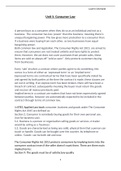Other
Applied Law Unit 5 Consumer Law and Exclusion Clauses Course Work (Pearson exam board)
Distinction* level Consumer Law + Exclusion Clauses Course Work for Level 3 Applied Law - Assignment 1 covering learning outcome A = P1 P2 M1 D1. Throughout all relevant points are backed up by points of law including cases. Case Studies provided have also been linked appropriately with points ...
[Show more]




